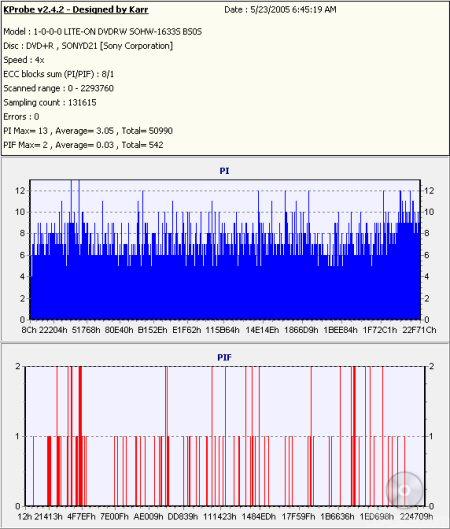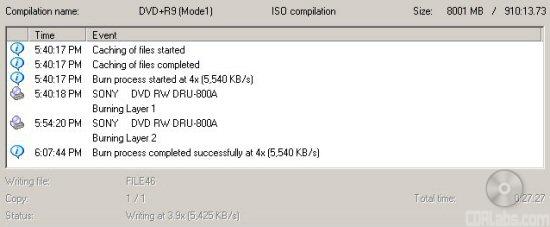DVD Write and ReWrite Tests - Nero Burning Rom 6.6.0.12 andDLA 4.90:
To test the DVD writing performance of Sony's new drive I used Verbatim 16x DVD+R, Memorex 16x DVD-R, Verbatim 6x DVD-RW and Verbatim 8x DVD+RW media. To get the writing times, a 4.38GB image was burned to our test discs using Nero.
When writing to DVD+R and DVD-R media at 16x, the DRU-800A uses CAV. By looking at the screenshots above, you can see that Lite-On's new drive starts writing at about 6.67x and accelerates, reaching its maximum speed as it reaches the end of the disc.
The DRU-800A also features 8x DVD+RW and 6x DVD-RW writing speeds. While the drive uses CLV when writing to DVD-RW media, it uses Z-CLV to reach its maximum DVD+RW writing speed.
| Sony DRU-800A |
Lite-On SOHW-1673S |
ASUS DRW-1608P |
Plextor PX-716A |
|
| DVD+R | 6:08 | 6:02 | 5:43 | 5:59 |
| DVD-R | 6:21 | 6:23 | 6:03 | 6:01 |
| DVD+RW | 7:46 | 7:47 | 14:25 | 7:35 |
| DVD-RW | 10:17 | 10:27 | 10:19 | 14:46 |
Sony's new drive performed pretty well in our DVD writing tests. While not as fast as some of the other drives when writing to DVD+R and DVD-R discs at 16x, it turned in some very good times with DVD+RW and DVD-RW media.
Sony doesn't really say whether or not the DRU-800A can write to 8x DVD±R media at 16x. To see if the drive had this capability, I ran a few tests using some of the media available in my area.
| Manufacturer ID | Max Write Speed |
Average Write Time |
|
| Taiyo Yuden 8x DVD+R | YUDEN000T02 | 8x | 8:45 |
| Memorex 16x DVD+R | CMC MAG M01 | 16x | 6:06 |
| Optodisc 16x DVD+R | OPTODISCR16 | 12x | 7:29 |
| RiDATA 16x DVD+R | RITEKR04 | 16x | 6:07 |
| Sony 16x DVD+R | SONYD21 | 16x | 6:14 |
| Verbatim 16x DVD+R | MCC-004 | 16x | 6:08 |
| Maxell 8x DVD-R | MXL RG03 | 8x | 8:57 |
| Taiyo Yuden 8x DVD-R | TYG02 | 8x | 8:56 |
| Memorex 16x DVD-R | CMC MAG.AM3 | 16x | 6:21 |
| Optodisc 16x DVD-R | OPTODISCR016 | 12x | 7:38 |
| Sony 16x DVD-R | SONY16D1 | 16x | 6:11 |
| Verbatim 16x DVD-R | MCC 03RG20 | 16x | 6:21 |
So what about writing quality? Testing a drive's DVD writing quality isn't easy. Until now, there were very few options, unless you wanted to shell out thousands of dollars for a certified test machine. Thanks to KProbe, we can test a disc's PI (Parity Inner) and PIF (Parity Inner Fail) rates.For these tests I used a Lite-On SOHW-1633S (firmware BS0S) and read the discs at 4x with the PI and PIF ECC sums set to 8 and 1 respectively. For comparison, I also tested the discs on a BenQ DW1620. When combined with Nero CD Speed, the DW1620 is able to report PI Errors, PI Failures, Parity Outer Failures and even jitter levels. For this test, the discs are read at 8x with both the PI and PIF ECC sums set to 8.
So what are "good" results supposed to look like? With KProbe, the PI errors should not exceed 280 and the number of PIF errors should stay below 4. When testing with CD Speed, the number of PI errors should stay below 280 as well. However, because it scans with an ECC sum of 8, a higher number of PIF errors is acceptable, as long as they do not exceed 32. Since POF errors are uncorrectable, we really don't want to see any of them at all.
I also put these discs through a "stress test" by reading them back with a Lite-On XJ-HD166S. By default, this DVD-ROM drive reads recordable media at only 8x. However, thanks to a firmware patched by The Dangerous Brothers, I was able to boost the drive's read speed to 12x. By reading these discs back at this speed, we can see if there are any readability issues caused by the number of errors or high levels of jitter.
|
|
|
||||||||||||||||||||||||||||||||||||||||||||||||||||||||||||||||||||||||
|
|
|
||||||||||||||||||||||||||||||||||||||||||||||||||||||||||||||||||||||||
When tested with KProbe, the DRU-800A's writing quality appears to be pretty good. With the exception of Optodisc's 16x DVD+R media, the error rates remained fairly low. Unfortunately, the results weren't nearly as good when scanned with the BenQ DW1620. Looking at the CD Speed screenshots, you can see that the PI/PIF rates were considerably higher, especially with the discs recorded at 16x.
|
|
|
||||||||||||||||||||||||||||||||||||||||||||||||||||||||||||||||||||||||
|
|
|
||||||||||||||||||||||||||||||||||||||||||||||||||||||||||||||||||||||||
The DRU-800A's writing quality wasn't much better with DVD-R discs. The 8x DVD-R media from Maxell and Taiyo Yuden yielded some fairly good results. However, when tested with the BenQ DW1620, the PI/PIF rates were considerably higher on the other discs.
| Sony DRU-800A |
Lite-On SOHW-1673S |
ASUS DRW-1608P |
Plextor PX-716A |
|
| DVD+RW Quick | 18 seconds | 20 seconds | 28 seconds | 32 seconds |
| DVD+RW Full | 7:51 | 7:54 | 14:25 | 7:46 |
| DVD-RW Quick | 1:05 | 1:08 | 50 seconds | 1:03 |
| DVD-RW Full | 10:37 | 10:38 | 10:22 | 15:09 |
To test the DRU-800A's packet writing performance I used DLA 4.90. Verbatim 8x DVD+RW and 6x DVD-RW media were used once again.
| Sony DRU-800A |
Lite-On SOHW-1673S |
ASUS DRW-1608P |
Plextor PX-716A |
|
| DVD+RW Write | 6:58 | 6:59 | 13:52 | 6:33 |
| DVD+RW Read | 9:04 | 9:04 | 14:28 | 5:47 |
| DVD-RW Write | 8:32 | 8:29 | 9:46 | 12:44 |
| DVD-RW Read | 9:22 | 9:18 | 11:40 | 6:05 |
The DRU-800A performed pretty well in our packet writing tests. The drive turned in some very good writing times with both DVD-RW and DVD+RW media. However, it was not nearly as fast as the PX-716A when reading back our test data.
Double Layer DVD Write Tests - Nero Burning Rom 6.6.0.12:
To test the double layer DVD writing performance of the DRU-800A, I used Verbatim 2.4x DVD+R DL, RiDATA 2.4x DVD+R DL and Verbatim 4x DVD-R DL media. I created about 8GB of random files and directories on my hard drive and then burned them to our test discs with Nero.
According to Sony, the DRU-800A writes to DVD+R DL media at 4x. Using CD Speed we can see that aside from the slight dip at the layer change, the drive writes at this speed from start to finish.
Sony's new drive had no problems writing to Verbatim's DVD+R DL media at 4x. Unfortunately, RiDATA's Ritek manufactured discs would not work at anything faster than 2.4x.
| DVD+R DL Write | Sony DRU-800A |
Lite-On SOHW-1673S |
ASUS DRW-1608P |
Plextor PX-716A |
| 2.4x | 43:17 | 43:13 | 44:20 | 43:42 |
| 4x | 26:23 | 26:23 | 26:55 | 26:47 |
| 6x | n/a | n/a | 18:55 | 18:17 |
While Sony's new DVD writer was no match for the PX-716A and DRW-1608P, it had no problems holding its own against the SOHW-1673S. In our tests, the DRU-800A took a respectable 26:23 to write 8001MB of data. So what about writing quality? Take a look below.
|
|
||||||||||||||||||||||||||||||||||||||||||||||||
The DRU-800A's writing quality was pretty good with Verbatim's DVD+R DL media. Aside from a slight spike at the layer change, the PI/PIF rates remained fairly low from start to finish. Unfortunately, the results weren't as good with RiDATA's DVD+R DL media. The error rates were much higher this time around, especially when tested with the BenQ DW1620. Surprisingly enough, this didn't seem to have any effect on readability.
The DRU-800A is the first drive from Sony with the ability to write to DVD-R DL media. To test its writing times, Verbatim's new 4x DVD-R DL media was used.
As you can see, Sony's new drive had no problems writing to Verbatim's DVD-R DL media at 4x. Aside from the slight dip at the layer change, the drive wrote to it at 4x from start to finish.
| Sony DRU-800A |
ASUS DRW-1608P |
Plextor PX-716A |
|
| DVD-R DL Write | 27:27 | 19:26 | 19:01 |
With its 4x writing speed, the DRU-800A wasn't nearly as fast as the drives from ASUS and Plextor. In our tests, it took Sony's new drive 27:27 to write 8001MB of data. So what about writing quality? Take a look below.
|
||||||||||||||||||||||||
Normally, when testing with KProbe I use a Lite-On SOHW-1633S. Unfortunately, this drive has some problems reading DVD-R DL media. To get around this problem, I tested the writing quality using Lite-On's newer 16x DVD±RW, the SOHW-1673S.
The DRU-800A's writing quality was pretty good here. The PI/PIF rates stayed within acceptable limits when tested with both KProbe and CD Speed and aside from a few small dips in the transfer rate graphs, there were no readability problems.
Performance Revisited:
Overall, the performance of Sony's new DVD+RW drive was pretty mixed. The DRU-800A held its own relatively well when writing to DVD±R and DVD±RW media. However, there were a number of cases where the writing quality could have been better. When it came to reading DVD's, the DRU-800Awas able to read single layer data DVD's at 16x and most recordable media at 8x, but slowed to 5.7x when reading DVD±R DL discs.
The DRU-800A also did pretty well in our CD read tests. With the Turbo Boost enabled, the drive was able to reach some pretty impressive transfer speeds with pressed and CD-R media. However, the seek times were occasionally a little high.. Writing CD's wasn't a problem for the DRU-800A either. The drive turned in some very impressive times and its writing quality was quite good. With all things considered, the Sony DRU-800A gets a 7 out of 10 for the performance section of this review.
























